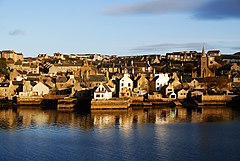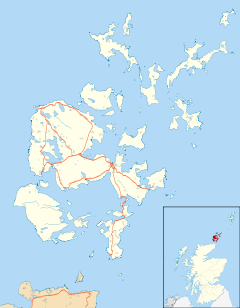Stromness
Stromness
|
|
|---|---|
 A view of Stromness |
|
| Stromness shown within Orkney | |
| Population | 2,200 (approx.) |
| OS grid reference | HY2509 |
| Council area | |
| Lieutenancy area | |
| Country | Scotland |
| Sovereign state | United Kingdom |
| Post town | STROMNESS |
| Postcode district | KW16 |
| Dialling code | 01856 |
| Police | Scottish |
| Fire | Scottish |
| Ambulance | Scottish |
| EU Parliament | Scotland |
| UK Parliament | |
| Scottish Parliament | |
Stromness local /ˈstrɒmnəs/ is the second most populated town in Orkney, Scotland. It is in the south-west of Mainland Orkney. It is also a parish, with the town of Stromness as its capital.
The name "Stromness" comes from the Norse Straumsnes.Straum refers to the strong tides that rip past the Point of Ness through Hoy Sound to the south of the town. Nes means "headland". Stromness thus means "headland protruding into the tidal stream". In Viking times the anchorage where Stromness now stands was called Hamnavoe, meaning "peaceful" or "safe harbour".
A long-established seaport, it has a population of approximately 2,190 residents. The old town is clustered along the characterful and winding main street, flanked with houses and shops built from local stone, with narrow lanes and alleys branching off it. There is a ferry link from Stromness to Scrabster on the north coast of mainland Scotland.
First recorded as the site of an inn in the 16th century, Stromness became important during the late 17th century, when England was at war with France and shipping was forced to avoid the English Channel. Ships of the Hudson's Bay Company were regular visitors, as were whaling fleets. Large numbers of Orkneymen, many of whom came from the Stromness area, served as traders, explorers and seamen for both. Captain Cook's ships, Discovery and Resolution, called at the town in 1780 on their return voyage from the South Seas where Cook had been killed.
...
Wikipedia

